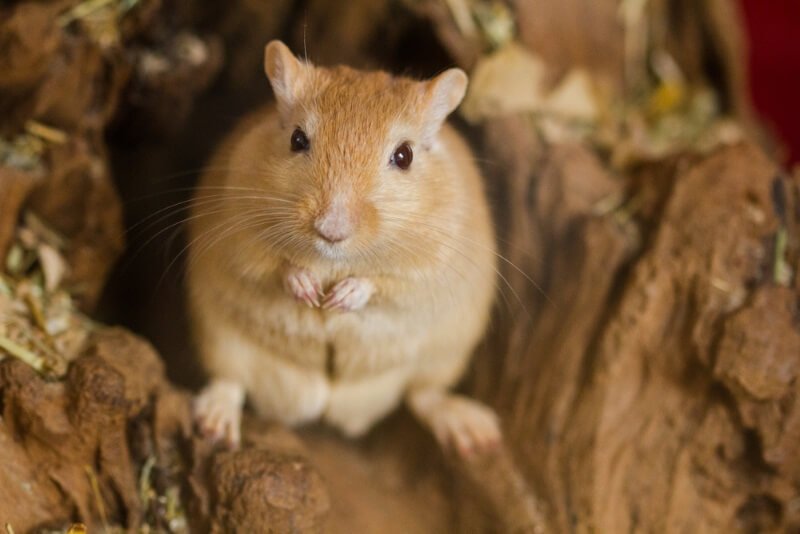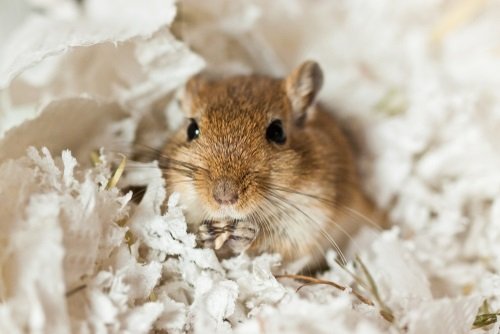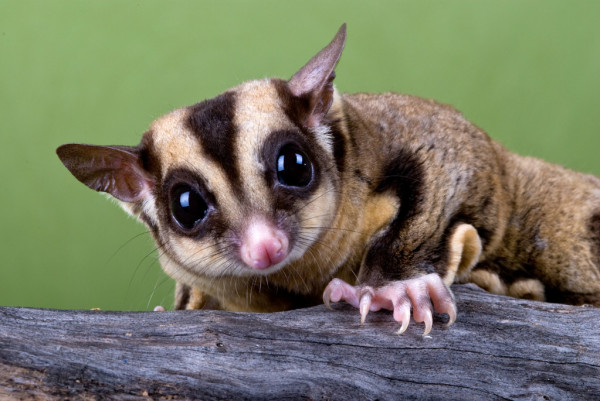The 8 Different Types Of Gerbils Every Pet Lover Should Know
This page contains affiliate links. We may earn money or products from the companies mentioned in this post through our independently chosen links, which earn us a commission. Learn More
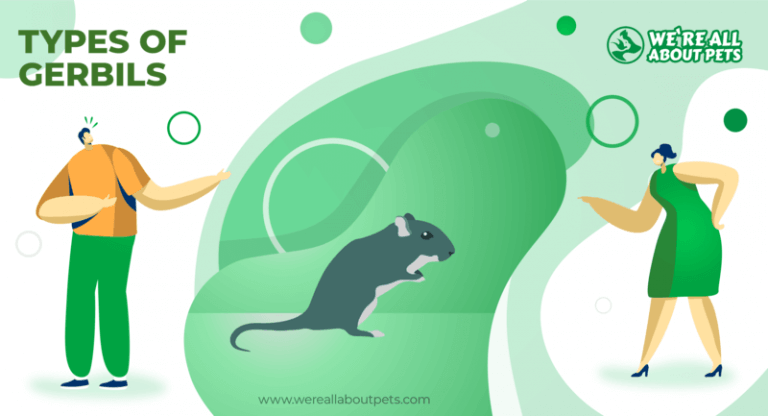
Pet shops around the world are stocked with popular pets like hamsters and guinea pigs, but these aren’t the only options. If you’re looking for a small pet that is easy to care for, amenable to handling, and doesn’t take up a lot of space, consider the gerbil!
Like many pets, there are several different types of gerbil and they are all different. Read on to learn the difference between the various gerbil species so you can decide which one is right for you.
8 Popular Types Of Gerbil Breeds
Gerbils are a type of rodent (order Rodentia) belonging to the subfamily Gerbillinae. There are about 110 species in this subfamily and there is currently a great deal of debate among taxonomists when it comes to the naming of the different gerbil species. Many are currently classified in tribes, some with multiple genera.
Once known as desert rats, the gerbil family includes a variety of small Asian rodents such as sand rats and jirds. These rodents are highly adapted to arid climates and are mostly active during the day. Gerbils were given their name as a diminutive form of “jerboa” which is the name of an unrelated type of rodent that inhabits a similar ecological niche.
The two types of gerbil most commonly found in pet stores are the Mongolian gerbil (Meriones unguiculatus) and the fat-tailed gerbil (Pachyuromys duprasi).
Here’s a quick overview of some of the types of gerbil and jird:
1. Mongolian Gerbil (Meriones Unguiculatus)

- Origin: China, Mongolia
- Price: $5 to $10
- Size: 6 to 12 inches
- Color: Varied
The most popular gerbil species in the United States is the Mongolian gerbil. As you can guess from the name, this species is found in Mongolia and China. These gerbils typically inhabit desert, shrubland, and grassland habitats where the live in semidesert regions and in the steppes.
The Mongolian gerbil typically lives in patriarchal groups consisting of a single parental pair along with the most recent litter and a few of the older pups. Sexually mature females mate based on dominance and dominant females will only mate with dominant males while in heat.
Mongolian gerbils and the various different species of gerbils come in a variety of coat colors. Wild gerbils tend to come in varying shades of light brown, grey, or yellow but captive-bred gerbils have been developed in a variety of different colors through selective breeding.
2. Fat-Tailed Gerbil (Pachyuromys Duprasi)
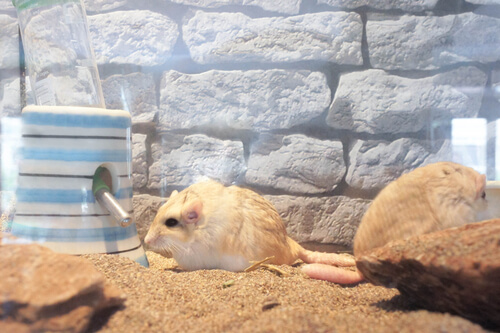
- Origin: Algeria, Libya, Egypt, Tunisia
- Price: $20 to $40
- Size: 6 to 12 inches
- Color: Yellow, grey
While the Mongolian gerbil has a long tail measuring up to 4 ½ inches long, the fat-tailed gerbil has a much shorter tail. Though the tail is only 2 inches in length, it is much wider. These gerbils are usually a little smaller on the whole as well, having a body length of up to 4 inches.
Fat-tailed gerbils are primarily insectivorous in the wild, though they’ll follow a similar diet to Mongolian gerbils or hamsters in captivity. These hamsters are named not only for the appearance of their tails, but because they can store fat in the tail for lean times.
These gerbils are particularly fond of burrowing, so they need several inches of soft bedding like wood shavings, though pine and cedar should be avoided. The fat-tailed gerbil is a social species, but can be kept alone as well as in colonies.
3. Pale Gerbil (Gerbillus Perpallidus)
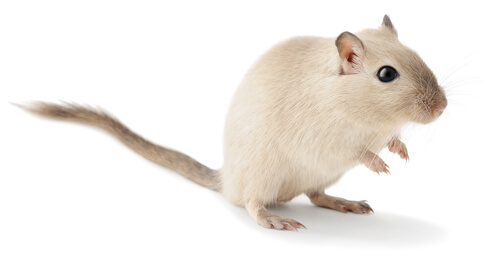
- Origin: Egypt
- Price: Unknown
- Size: Up to 11 inches
- Color: Pale orange
Also known as the pallid gerbil, the pale gerbil is endemic to Egypt and is found primarily in the northwestern part of the country. Pale gerbils are pale orange in color with white underparts as well as white color on the forelimbs and feet. These gerbils grow up to 11 inches long and weigh up to 50g.
4. Shaw’s Jird (Meriones Shawi)
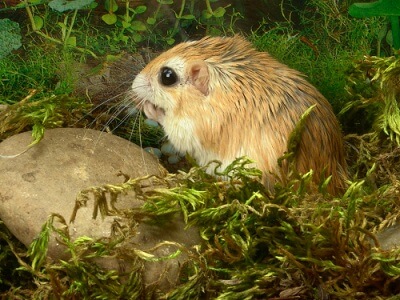
- Origin: North Africa
- Price: Unknown
- Size: Up to 14 inches
- Color: Varied
One of the most common rodents in North African countries, Shaw’s jird is the least common gerbil found in the pet trade. Shaw’s jird is larger than most gerbils and less sociable –female jirds of this species are particularly aggressive. When it comes to handling by humans, however, they are docile.
While the wild Shaw’s jird is short-haired with a sandy, agouti coloration, some long-haired varieties have started to surface. You may also find a chinchilla mutation and a white-spotted jird.
5. Great Gerbil (Rhombomys Opimus)
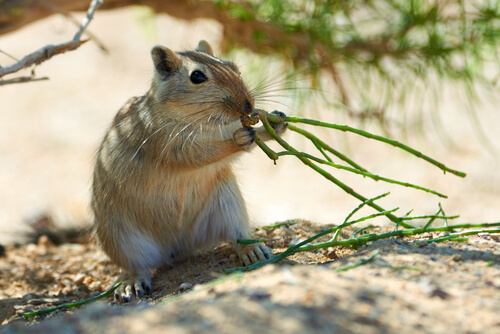
- Origin: Central Asia
- Price: Unknown
- Size: 6 to 12 inches
- Color: Grey, yellow
The largest gerbil found throughout Central Asia, the great gerbil measures 6 to 8 inches in body alone. What makes these gerbils distinctive from other gerbil species is their skulls have two grooves in each incisor and they have large front claws used for burrowing.
The great gerbil lives in family groups and they are primarily diurnal animals that feed mostly on vegetable matter.
6. North African Gerbil (Dipodillus Campestris)
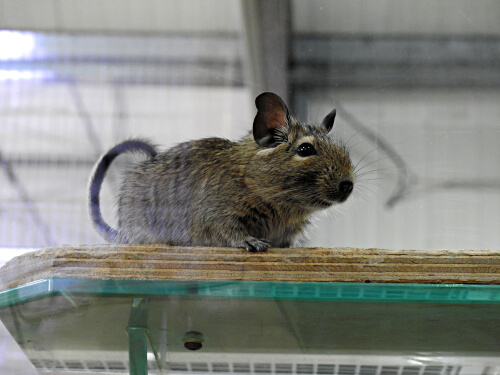
- Origin: North Africa
- Price: Unknown
- Size: 6 to 12 inches
- Color: Brown, orange-brown
The North African gerbil has cinnamon to orange-brown fur on the top of its body with white cheeks and a white throat. These gerbils may also have a dark stripe on the nose with a clear division between the dorsal color and the ventral colors. The tail makes up about 40% of the rodent’s total length.
7. Tamarisk Jird (Meriones Tamariscinus)
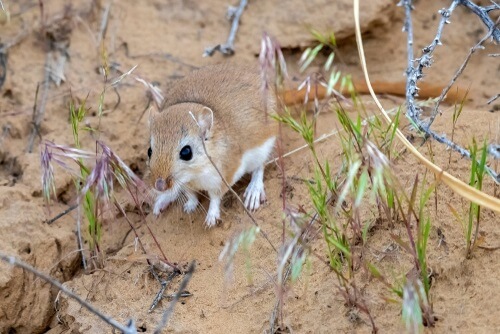
- Origin: Asia
- Price: Unknown
- Size: Up to 140 grams
- Color: Varied
Found primarily in China, Mongolia, and other Asian countries, these jirds inhabit grasslands and shrublands where they can find plenty of cover. This species is fairly large in size, weighing up to 140 grams at maturity, and they are nocturnal. This species reaches sexual maturity at 70 days but, unlike many species, many females don’t breed in their first year.
8. Guinean Gerbil (Gerbilliscus Guineae)
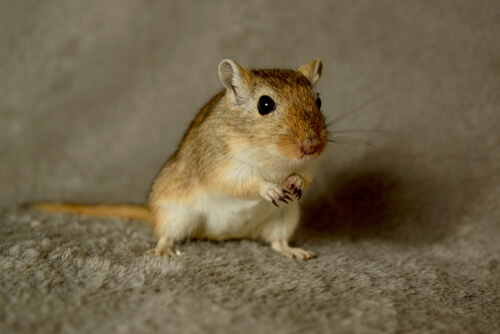
- Origin: Guinea
- Price: Unknown
- Size: 6 to 12 inches
- Color: Grey-brown
The Guinean gerbil is found in Guinea, Ghana, Mali, Senegal, Sierra Leone, and the Ivory Coast. These gerbils live in subtropical and tropical dry forests as well as dry savannah and rocky areas.
This is a fairly large gerbil species, having a body length around 6 inches with another 7 inches of tail. Guinea gerbils have slightly rounded snouts with large eyes and elongated ears.
The Benefits Of Owning A Pet Gerbils
Every pet has its own list of pros and cons, so it’s important to do your research to know you’re making the best choice for yourself and your family. Gerbils are small rodents and generally do well with handling, but they have specific needs that must be met to stay healthy and happy.
If you’re committed to being a responsible pet owner, however, they are very popular pets for good reason.
Here are some of the benefits of gerbils as pets:
- The gerbil is not typically an aggressive animal and will rarely bite unprovoked. They are small animals and fairly easy to tame – they can even form strong bonds with their owners. Keep in mind they can be fragile due to their size, so may not be ideal for small or very young children.
- The cost to keep a gerbil as a pet is fairly low because they are small and their habitat requirements are minimal. Just be sure to provide a suitable habitat and healthy diet.
- Many gerbil species are social animals, so you may be able to keep your gerbil with others of its kind. Make sure you provide ample space if you’re keeping more than one rodent and be careful about combining gerbils from different litters as much as possible.
- Gerbils are relatively easy to feed, particularly with a staple diet of commercial gerbil food. Just be sure to provide a water bottle of fresh water and a variety of other fresh foods.
- A healthy gerbil is very active, so these pets will always keep you entertained. Just be sure to provide an exercise wheel so they can work off their energy as well as bedding to burrow in. Your gerbil will also appreciate having some toys as well as things to climb and explore.
- Pet gerbils don’t take up a lot of space which makes them a great choice for apartment dwellers and other small spaces. They should be given a spacious cage, but a single gerbil only needs about 12x24x12 inches of space (though more is always better).
The first thing many people think of when considering a gerbil as a pet is their small size. While gerbils are small animals that don’t take up a lot of space, that’s not the only thing you need to know about them. Read on to learn some other important facts to consider before getting a gerbil.
What To Know Before Getting A Pet Gerbil?
While gerbils make great pets, they are living creatures like any other and need a certain degree of care. Be sure to do your research before getting a pet gerbil so you know what you’re getting into and so you can be sure to provide for your new pet’s needs.
Here are some other important things to consider for pet gerbils:
- Gerbils are very social animals, living in large groups in the wild, but they have been known to attack gerbils from other litters when they have an unfamiliar scent. Be careful when introducing gerbils from separate litters.
- While gerbils are popular as a small pet in many areas, they can pose a threat to indigenous ecosystems as well as agricultural operations. It is illegal to import gerbils into New Zealand and illegal to purchase, import, or keep a gerbil as a pet in California.
- There are some obvious visible similarities between gerbils and other rodents like hamsters, though not as much with the guinea pig. The biggest difference is that gerbils have a long tail. Be careful not to pick the gerbil up by the tail because the tuft and the skin are fragile.
- Gerbils like to chew and gnaw on things, so be careful what type of cage you choose. Avoid cages made with plastic materials and choose one with a secure top so your pet doesn’t escape. Provide sturdy chew toys as well to keep your gerbil busy.
Whether you’re looking for a small pet that won’t take up a lot of space or an active pet to keep you entertained, the gerbil is well worth considering. Take what you’ve learned here to decide which type of gerbil to get then check out our other guides to get started with your new pet!






